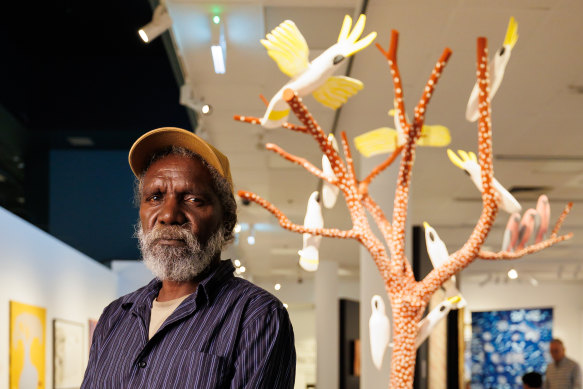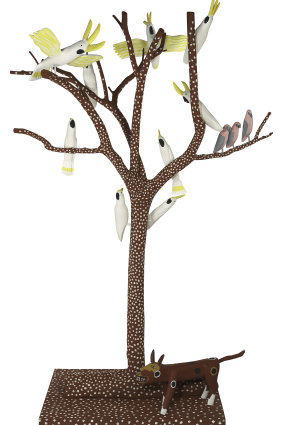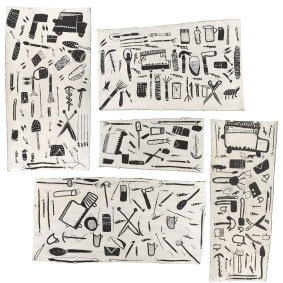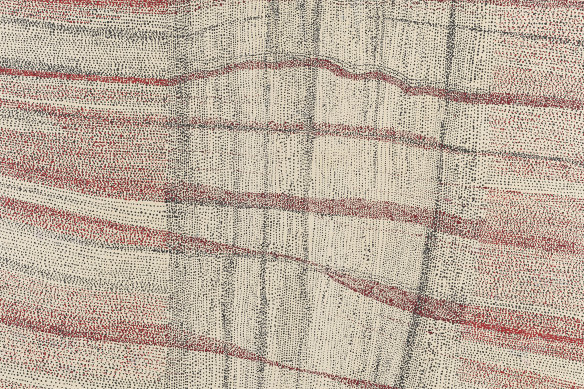Save articles for later
Add articles to your saved list and come back to them any time.
Another hot August night in Darwin, another National Aboriginal and Torres Strait Islander Art Awards. It was the 40th occasion this event has been celebrated at the Museum and Art Gallery of the Northern Territory (MAGNT), and rarely has it gone off so smoothly. Things felt a little tentative last year as the industry emerged from the pandemic, but the intervening 12 months have given everybody a chance to find new creative vigour and productivity.
The NATSIAA is indisputably the year’s major Aboriginal art event. It coincides with the Darwin Festival, which encompasses a broad range of activities, including the Darwin Aboriginal Art Fair (DAAF), the National Indigenous Fashion Awards, and the National Indigenous Music Awards. There is a lot of cross-over between categories, with some communities excelling in painting, sculpture, fashion design, and music.
Keith Wikmunea with his work Ku’, Theewith & Kalampang: The White Cockatoo, Galah and the Wandering Dog.Credit: Charlie Bliss
Aside from the big awards ceremonies, the festival hosts a series of important satellite exhibitions that showcase the best-emerging talent. Under the title Salon Art Projects, two local dealers, Paul Johnstone and Matt Ward, have organised a Salon des Refusés; dual painting and sculpture shows with a bird theme; and excellent solo exhibitions at their respective galleries: Bugai Whyoulter at the Paul Johnstone Gallery, and Binygurr Wirrpanda, at Outstation.
The Northern Centre of Contemporary Art (NCCA) has a frankly hilarious show called Blak Power: 50 Years of First Nations Superheroes in Australian Art, which gathers together a surprising number of Indigenous artists working with a comic book superhero theme.
Just around the corner in Parap, the Laundry Gallery has a tempting show of sculptural pieces from Anindilyakwa Arts of Groote Eylandt. Back in the city, at the Doubletree by Hilton, there is an annual survey of new work by Tiwi artists, presented by Munupi Arts and Jilamara Arts and Crafts, from Melville and Bathurst Islands. There’s also a student show called Remix at the Charles Darwin University Gallery, and work by Gary Lee at Coconut Studios.
Keith Wikmunea’s Theewith & Kalampang: White Cockatoo, Gilah and the Wandering Dog that won the $100,000 prize.
Both the NATSIAA, and especially, the Salon des Refusés, were noticeably better than last year’s efforts, and the same could be said for the Tiwi show. The most likely reason for this upsurge is that last year artists were still in post-lockdown mode and feeling a little tentative. They have since been able to sit down together and make new work, benefitting from the company and perhaps the competition. There’s a palpable sense of new energy, and that’s good news for the entire sector at a time when question marks over the practices of the APY Art Centre Collective (APYACC) have cast a shadow on the Indigenous art market.
The dedicated art buyers who make their way to Darwin every year don’t seem to have been discouraged by the controversy. These collectors – who are discriminating in a way that casual, speculative buyers are not – simply steer clear of anything suspicious. If there was ever a moment of crisis it was a mere blip.
It’s another matter altogether as to how the APYACC will come out of its tailspin. The group was not allowed to exhibit as a collective in the DAAF, and Adam Worrall, one year into the job as director of MAGNT, has taken a stand by saying he will not work with any organisation that has been expelled from the Indigenous Art Code. The basis of trust between seller and buyer has been undermined, and the biggest problem may be how institutions and art prizes should deal with works by associated artists.
Among the 63 finalists in the NATSIAA there are eight to 10 artists from the APY lands. It’s hard to be more precise because a place like Umoona (Cooper Pedy) has been linked with the APYACC, while Ernabella located on the APY Lands, is a fully independent entity, established in 1948.
The NATSIAA exhibitors include Yaritji Tingila Young, the artist whose work kicked off the controversy. We can take this as assurance that it is not individual artists who are being criticised, but the APYACC business model. When the management issues are sorted out, a new normal will prevail.
Dhalmula Burarrwaŋa won the Emerging Artist Award.
This year’s NATSIAA judges steered clear of controversy by giving the $100,000 Telstra Art Prize to Keith Wikmunea of Aurukun, for a large, painted sculpture, Ku’, Theewith & Lalampang: The White Cockatoo, Galah and the Wandering Dog. It’s a vibrant, playful, sustained feat of wood carving that cries out: “Look at me!”
Julie Nangala Robertson took out the Telstra General Painting Award for Mina Mina, a work that casts a subtle veil across the landscape. Robertson is the daughter of the late Dorothy Napangardi, a previous winner of the Painting Award and the Telstra Prize. Aside from the delicate beauty of the painting, it’s encouraging to see the evolution of a talented second-generation artist.
Another irresistible work was Dhalmula Burarrwanga’s wanha, dhika, nhwai?, which won the Telstra Emerging Artist Award. Dhalmula looks back to a distinguished artist grandmother, Nancy Gaymala Yunupingu, but her subject is witty, secular, and universally relevant. The three words of the title are what Yolngu people say when they’ve misplaced their keys or their phone, or a similar ordinary-but-vital item. On four pieces of bark painted white, the artist has inscribed the black silhouettes of such everyday objects clustered in some limbo while we search for them in vain. Forget about the spiritual stuff, this is modern life.
I haven’t the space to write about every award winner, but it would be shameful to overlook Jimmy John Thaiday’s second successive Telstra Multimedia Award, for a stunning 5-minute video called Just Beneath the Surface. In a rhapsodic portrait of the earth, sky and ocean in the Torres Strait, Thaiday makes a case for humanity living in harmony with nature, pushing beneath the surface to discover the wealth by which we are surrounded.
A detail of Julie Nangala Robertson’s Ngapa Jukurrpa (Water Dreaming) – Pirlinyarnu which won the General Painting Award.
Among stand-outs that didn’t take home any awards, I was struck by a large, dynamic painting by Rachael Lionel of Ernabella. Her Dust Storm features a series of dynamic splashes, created by the densest application of dots. The Italian Futurists couldn’t have done it any better.
No less dynamic was Wurrandan Marawili’s Yathikpa – the fire in the sea, which consists of three tall, precisely-welded chains of steel diamond shapes, partly covered with the red & white flickers of found signage, partly engraved with traditional patterns. The work would be accepted anywhere as contemporary abstract sculpture, but it’s more than that – both a powerful evocation of the elements, and the story of fire arising from the water, then being carried to the open sea by an ancestral crocodile.
Each of the satellite shows deserves a review in its own right, but at the very least I need to acknowledge the brilliance of another Yolngu artist, Binygurr Wirrpanda, at Outstation. It was the one-and-only Gunybi Ganambarr (also a 2023 NATSIAAA finalist) who started engraving traditional motifs on metal, but other artists have been quick to follow his lead. Wurrandan and Binygurr have responded to Gunybi’s breakthrough and added their own innovations.
Binygurr’s show, whose English-language title is: My mind is the spring, my body the shark, includes work in a range of styles and mediums. There are engravings on metal, paintings on bark, a decorated pole, plaque-style pieces that sit flat on the wall or dangle from the ceiling. It’s an impressive display, dominated by a strange, repetitive shape that Matt Ward believes is a representation of a reservoir. The artist has neither confirmed nor denied. He understands that it’s less important to identify this motif than to watch the way it dances from one work to the next, from bark to metal and back again.
Finally, to another artist who reduces me to the state of fandom. Bugai Whyoulter at the Paul Johnstone Gallery is an elderly Kartujarra woman from the Pilbara, who started painting late in life – as has been the case for so many great Aboriginal artists – and discovered an extraordinary aptitude. The paintings in the show, Ngaya Bugai (I Am Bugai), are lyrical responses to the artist’s homeland, with its sand and salt pans, wind and sun, and a sense of unfathomable age. Bugai extracts a wide array of moods from this landscape, signified by changes of tonality, from dirty yellow to blue-grey; from a vivid red, to a deep, dark tone that veers towards purple. There is nothing flashy about her use of colour, applied with an instinctive skill that imbues these apparently simple paintings with depth and feeling.
Some artists strive for the grand statement, some favour the slow build-up. With Bugai it’s best to get to know her work in an exhibition like this, where one may see how the paintings play off each other, adding layers of emphasis or touches of contrast, like instruments joining a symphony. The effect is properly cumulative, leaving us to wonder how these restrained, windswept canvases create such a monumental impression.
National Aboriginal and Torres Strait Islander Art Awards 2023 is at the Museum and Art Gallery of the Northern Territory, Darwin, until February 18.
John McDonald was a guest of NATSIAA.
Most Viewed in Culture
From our partners
Source: Read Full Article






